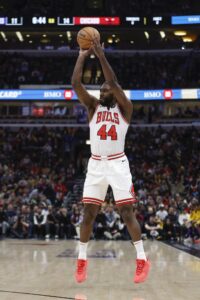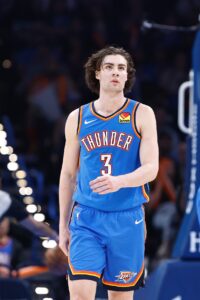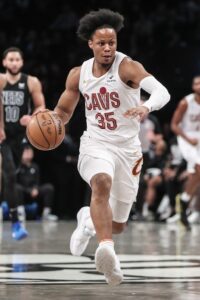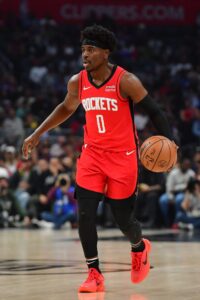Hoops Rumors’ up-to-date list of 2025 free agents by team is below. These are players who are eligible for restricted or unrestricted free agency after the 2024/25 season.
Players with team or player options for the 2025/26 season are listed, unless they’re rookie scale options. Potential restricted free agents are marked with (RFA).
This list will continue to be updated throughout the 2024/25 season, so be sure to use it and our list of 2025 free agents by position/type as points of reference.
Both lists can be found anytime under “Hoops Rumors Features” on the right-hand sidebar of our desktop site, or in the “Free Agent Lists” section of our mobile menu. If you have any corrections or omissions, please contact us.
Updated 10-23-24 (6:13am CT)
Atlanta Hawks
- Clint Capela
- Garrison Mathews
- Larry Nance Jr.
- Dominick Barlow (two-way)
- Seth Lundy (two-way)
- Keaton Wallace (two-way)
Boston Celtics
- Al Horford
- Luke Kornet
- Jaden Springer (RFA)
- JD Davison (two-way)
- Drew Peterson (two-way)
- Anton Watson (two-way)
Brooklyn Nets
- Bojan Bogdanovic
- Dennis Schröder
- Ben Simmons
- Trendon Watford
- Day’Ron Sharpe (RFA)
- Cam Thomas (RFA)
- Ziaire Williams (RFA)
- Dorian Finney-Smith ($15,378,480 player option)
- Keon Johnson ($2,349,578 team option)
- Jalen Wilson ($2,221,677 team option)
- Jaylen Martin (two-way)
- Tyrese Martin (two-way)
Charlotte Hornets
- Seth Curry
- Taj Gibson
- Tre Mann (RFA)
- Vasilije Micic ($8,109,150 team option)
- Moussa Diabate (two-way)
- Jared Rhoden (two-way)
Chicago Bulls
- Lonzo Ball
- Torrey Craig
- Talen Horton-Tucker
- Chris Duarte (RFA)
- Josh Giddey (RFA)
- Jevon Carter ($6,809,524 player option)
- E.J. Liddell (two-way)
- Adama Sanogo (two-way)
- DJ Steward (two-way)
Cleveland Cavaliers
- Ty Jerome
- Caris LeVert
- Sam Merrill
- Tristan Thompson
- Emoni Bates (two-way)
- JT Thor (two-way)
- Luke Travers (two-way)
Dallas Mavericks
- Spencer Dinwiddie
- Dante Exum
- Markieff Morris
- Quentin Grimes (RFA)
- Kyrie Irving ($43,962,963 player option)
- Dwight Powell ($4,000,000 player option)
- Kessler Edwards (two-way)
- Jazian Gortman (two-way)
- Brandon Williams (two-way)
Denver Nuggets
- Vlatko Cancar
- DeAndre Jordan
- Dario Saric ($5,426,400 player option)
- Russell Westbrook ($3,468,960 player option)
- Trey Alexander (two-way)
- PJ Hall (two-way)
- Spencer Jones (two-way)
Detroit Pistons
- Malik Beasley
- Tim Hardaway Jr.
- Daniss Jenkins (two-way)
- Cole Swider (two-way)
Golden State Warriors
- Kevon Looney
- De’Anthony Melton
- Gary Payton II
- Lindy Waters
- Jonathan Kuminga (RFA)
- Moses Moody (RFA)
- Gui Santos ($2,221,677 team option)
- Reece Beekman (two-way)
- Quinten Post (two-way)
- Pat Spencer (two-way)
Houston Rockets
- Steven Adams
- Jeff Green
- Jae’Sean Tate
- Fred VanVleet ($44,886,930 team option)
- Aaron Holiday ($4,901,400 team option)
- N’Faly Dante (two-way)
- Jack McVeigh (two-way)
- Jeenathan Williams (two-way)
Indiana Pacers
- James Johnson
- Myles Turner
- Isaiah Jackson (RFA)
- James Wiseman ($2,546,675 team option)
- Enrique Freeman (two-way)
- Quenton Jackson (two-way)
- Tristen Newton (two-way)
Los Angeles Clippers
- Mohamed Bamba
- Amir Coffey
- P.J. Tucker
- Bones Hyland (RFA)
- James Harden ($36,346,154 player option)
- Nicolas Batum ($4,901,400 player option)
- Kevin Porter Jr. ($2,546,675 player option)
- Trentyn Flowers (two-way)
- Kai Jones (two-way)
- Jordan Miller (two-way)
Los Angeles Lakers
- Jaxson Hayes
- Cam Reddish
- D’Angelo Russell
- Christian Wood
- LeBron James ($52,627,153 player option)
- Christian Koloko (two-way)
- Quincy Olivari (two-way)
- Armel Traore (two-way)
Memphis Grizzlies
- Luke Kennard
- Santi Aldama (RFA)
- Jay Huff (two-way)
- Yuki Kawamura (two-way)
- Cam Spencer (two-way)
Miami Heat
- Thomas Bryant
- Alec Burks
- Josh Richardson
- Jimmy Butler ($52,413,394 player option)
- Duncan Robinson ($19,888,000 early termination option)
- Josh Christopher (two-way)
- Keshad Johnson (two-way)
- Dru Smith (two-way)
Milwaukee Bucks
- Brook Lopez
- Taurean Prince
- Gary Trent Jr.
- Delon Wright
- Khris Middleton ($34,012,345 player option)
- Bobby Portis ($13,445,754 player option)
- Pat Connaughton ($9,423,869 player option)
- Liam Robbins (two-way)
- Ryan Rollins (two-way)
- Stanley Umude (two-way)
Minnesota Timberwolves
- Nickeil Alexander-Walker
- PJ Dozier
- Joe Ingles
- Julius Randle ($30,935,520 player option)
- Naz Reid ($15,022,464 player option)
- Luka Garza ($2,349,578 team option)
- Josh Minott ($2,187,699 team option)
- Jaylen Clark (two-way)
- Jesse Edwards (two-way)
- Daishen Nix (two-way)
New Orleans Pelicans
- Javonte Green
- Brandon Ingram
- Jeremiah Robinson-Earl
- Daniel Theis
- Brandon Boston Jr. (two-way)
- Jamal Cain (two-way)
- Trey Jemison (two-way)
New York Knicks
- Precious Achiuwa
- Cameron Payne
- Jericho Sims
- Ariel Hukporti (two-way)
- Kevin McCullar (two-way)
- Jacob Toppin (two-way)
Oklahoma City Thunder
- Alex Caruso
- Alex Reese (RFA)
- Jaylin Williams ($2,187,451 team option)
- Alex Ducas (two-way)
- Adam Flagler (two-way)
- Ajay Mitchell (two-way)
Orlando Magic
- Moritz Wagner ($11,000,000 team option)
- Gary Harris ($7,500,000 team option)
- Cory Joseph ($3,468,960 team option)
- Caleb Houstan ($2,187,451 team option)
- Mac McClung (two-way)
- Trevelin Queen (two-way)
Philadelphia 76ers
- Reggie Jackson
- Kyle Lowry
- Guerschon Yabusele
- Kelly Oubre ($8,382,150 player option)
- Andre Drummond ($5,000,000 player option)
- Eric Gordon ($3,468,960 player option)
- Jeff Dowtin (two-way)
- Justin Edwards (two-way)
- Lester Quinones (two-way)
Phoenix Suns
- Bol Bol
- Tyus Jones
- Damion Lee
- Monte Morris
- Mason Plumlee
- Jalen Bridges (two-way)
- Collin Gillespie (two-way)
- TyTy Washington Jr. (two-way)
Portland Trail Blazers
- Dalano Banton
- Jabari Walker (RFA)
- Matisse Thybulle ($11,550,000 player option)
- Rayan Rupert ($2,221,677 team option)
- Bryce McGowens (two-way)
- Justin Minaya (two-way)
- Taze Moore (two-way)
Sacramento Kings
- Alex Len
- Trey Lyles
- Doug McDermott
- Jordan McLaughlin
- Orlando Robinson (RFA)
- Keon Ellis ($2,301,587 team option)
- Isaiah Crawford (two-way)
- Isaac Jones (two-way)
- Mason Jones (two-way)
San Antonio Spurs
- Charles Bassey
- Tre Jones
- Sandro Mamukelashvili
- Chris Paul
- David Duke (two-way)
- Harrison Ingram (two-way)
- Riley Minix (two-way)
Toronto Raptors
- Chris Boucher
- Bruce Brown
- Bruno Fernando
- Garrett Temple
- Davion Mitchell (RFA)
- Branden Carlson (two-way)
- D.J. Carton (two-way)
Utah Jazz
- Patty Mills
- John Collins ($26,580,000 player option)
- Micah Potter (two-way)
- Jason Preston (two-way)
- Oscar Tshiebwe (two-way)
Washington Wizards
- Marvin Bagley III
- Malcolm Brogdon
- Jared Butler (two-way)
- Justin Champagnie (two-way)
- Tristan Vukcevic (two-way)

 The most interesting move of the Bulls’ summer was trading defensive ace
The most interesting move of the Bulls’ summer was trading defensive ace  As our Luke Adams
As our Luke Adams 
 The team also made a minor move on the trade market by acquiring
The team also made a minor move on the trade market by acquiring